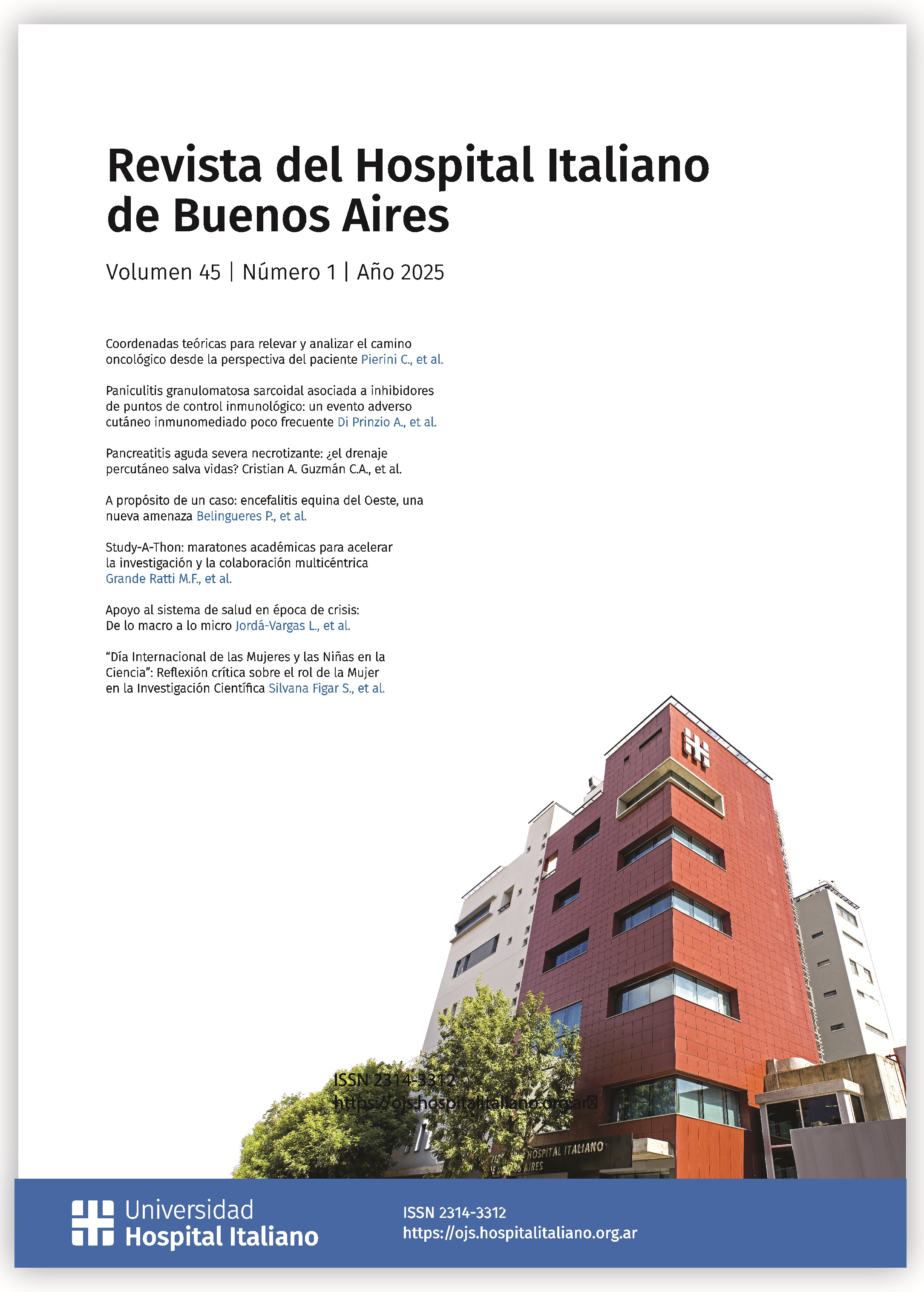Severe Necrotizing Acute Pancreatitis: Does Percutaneous Drainage Save Lives?
Main Article Content
Abstract
Acute pancreatitis is an inflammation of the pancreas that destroys acinar cells. Its incidence has increased globally, primarily due to biliary lithiasis and alcoholism. This report describes a 58-yearold man with a history of alcoholism who developed acute pancreatitis after consuming fatty foods and alcohol. Initially managed conservatively, he developed complications requiring admission to the ICU. Computed tomography (CT) revealed multiple necrotic collections, managed by CT-guided percutaneous drainage. After five weeks, the patient showed significant improvement, allowing removal of the catheters and discharge with outpatient follow-up. This case highlights the “Step-Up Approach”, favoring minimally invasive techniques like percutaneous drainage over open necrosectomy in severe necrotizing pancreatitis, improving survival and reducing complications. Multidisciplinary management is essential to optimize clinical outcomes.
Downloads
Article Details
Section

This work is licensed under a Creative Commons Attribution-NonCommercial-ShareAlike 4.0 International License.
How to Cite
References
Muñoz D, Medina R, Botache WF, et al. Pancreatitis aguda: puntos clave. Revisión argumentativa de la literatura. Rev Colomb Cir. 2023;38(2):339-351. https://doi.org/10.30944/20117582.2206. DOI: https://doi.org/10.30944/20117582.2206
Zheng Z, Ding YX, Qu YX, et al. A narrative review of acute pancreatitis and its diagnosis, pathogenetic mechanism, and management. Ann Transl Med. 2021;9(1):69. https://doi.org/10.21037/atm-20-4802. DOI: https://doi.org/10.21037/atm-20-4802
Bhakta D, de Latour R, Khanna L. Management of pancreatic fluid collections. Transl Gastroenterol Hepatol. 2022;7:17. https://doi.org/10.21037/tgh-2020-06. DOI: https://doi.org/10.21037/tgh-2020-06
Yang Y, Zhang Y, Wen S, et al. The optimal timing and intervention to reduce mortality for necrotizing pancreatitis: a systematic review and network meta-analysis. World J Emerg Surg. 2023;18(1):9. https://doi.org/10.1186/s13017-023-00479-7. DOI: https://doi.org/10.1186/s13017-023-00479-7
van Santvoort HC, Bakker OJ, Bollen TL, et al. A conservative and minimally invasive approach to necrotizing pancreatitis improves outcome. Gastroenterology. 2011;141(4):1254-1263. https://doi.org/10.1053/j.gastro.2011.06.073. DOI: https://doi.org/10.1053/j.gastro.2011.08.012
Khizar H, Zhicheng H, Chenyu L, et al. Efficacy and safety of endoscopic drainage versus percutaneous drainage for pancreatic fluid collection; a systematic review and meta-analysis. Ann Med. 2023;55(1):2213898. https://doi.org/10.1080/07853890.2023.2213898. DOI: https://doi.org/10.1080/07853890.2023.2213898
Song Y, Lee SH. Recent treatment strategies for acute pancreatitis. J Clin Med. 2024;13(4):978. https://doi.org/10.3390/jcm13040978. DOI: https://doi.org/10.3390/jcm13040978
Baron TH, Thaggard WG, Morgan DE, et al. Endoscopic therapy for organized pancreatic necrosis. Gastroenterology. 1996;111(3):755-764. https://doi.org/10.1053/gast.1996.v111.pm8780582. DOI: https://doi.org/10.1053/gast.1996.v111.pm8780582
Freeny PC, Hauptmann E, Althaus SJ, et al. Percutaneous CT-guided catheter drainage of infected acute necrotizing pancreatitis: techniques and results. AJR Am J Roentgenol. 1998;170(4):969-975. https://doi.org/10.2214/ajr.170.4.9530046. DOI: https://doi.org/10.2214/ajr.170.4.9530046
van Baal MC, van Santvoort HC, Bollen TL, et al. Systematic review of percutaneous catheter drainage as primary treatment for necrotizing pancreatitis. Br J Surg. 2011;98(1):18-27. https://doi.org/10.1002/bjs.7304. DOI: https://doi.org/10.1002/bjs.7304
Navalho M, Pires F, Duarte A, et al. Percutaneous drainage of infected pancreatic fluid collections in critically ill patients: correlation with C-reactive protein values. Clin Imaging. 2006;30(2):114-119. https://doi.org/10.1016/j.clinimag.2005.09.026. DOI: https://doi.org/10.1016/j.clinimag.2005.09.026
Bala M, Almogy G, Klimov A, et al. Percutaneous "stepped" drainage technique for infected pancreatic necrosis. Surg Laparosc Endosc Percutan Tech. 2009;19(4):e113-118. https://doi.org/10.1097/SLE.0b013e3181a9d37d. DOI: https://doi.org/10.1097/SLE.0b013e3181a9d37d
Baudin G, Chassang M, Gelsi E, et al. CT-guided percutaneous catheter drainage of acute infectious necrotizing pancreatitis: assessment of effectiveness and safety. AJR Am J Roentgenol. 2012 ;199(1):192-199. https://doi.org/10.2214/AJR.11.6984. DOI: https://doi.org/10.2214/AJR.11.6984
Bang JY, Arnoletti JP, Holt BA, et al. An endoscopic transluminal approach, compared with minimally invasive surgery, reduces complications and costs for patients with necrotizing pancreatitis. Gastroenterology. 2019;156(4):1027-1040.e3. https://doi.org/10.1053/j.gastro.2018.11.031. DOI: https://doi.org/10.1053/j.gastro.2018.11.031
Baron TH, DiMaio CJ, Wang AY, et al. American Gastroenterological Association Clinical Practice Update: management of pancreatic necrosis. Gastroenterology. 2020;158(1):67-75.e1. https://doi.org/10.1053/j.gastro.2019.07.064. DOI: https://doi.org/10.1053/j.gastro.2019.07.064

